Entry Level SEO Tips
If you own a business, or if you help manage a business, then you have likely heard about SEO.
Whether you have a small or large marketing budget, understanding how SEO works is yet another relevant factor for businesses in 2023 and beyond.
In this guide, you’ll learn SEO techniques that have been curated from some of the best SEO’s in the world, as well as SEO tactics that have helped our clients build healthy and sustainable websites that continue to grow year over year.
- What is SEO?
- Why is SEO Important?
- How Do Search Engines Work?
- How to Track Your Site’s SEO
- Search Engine Crawling
- Search Engine Indexing
- Search Engine Ranking
- Understanding Search Intent
- Keyword Research
- Improve Your Domain Authority
- Understanding EAT – Expertise, Authority, and Trustworthiness
- Core Web Vitals
- How to Optimize for Visual Search
- How to Optimize for Audio Search
- How to Optimize for Video Search
- Why Should You Study the First Page Search Engine Results?
- What Is a Featured Snippet?
- What Is an Information Box?
- Localized Search Engine Optimization
- What Is a Local Map Pack?
- How to Rank in Local Search
- What is a Product Carousel?
- Product Examples in the Product Carousel
- What is CTR or Click-Through-Rate?
- What are the Best SEO Tools?
- On-Site Versus Off-Site Search Engine Optimization
- Understanding Technical SEO
- What are Backlinks and Why are they Important?
- How to Get Backlinks
- Be Inspired by Your SEO Competition
- Become a Valuable Resource with Infographics and Tutorials
- Look for Broken Links to Repair
- Use External Web Profiles Wisely
- Write Guest Posts
- Haro
- Flatter Others in Adjacent Fields
- Paid Backlinks
- What is Domain Authority and Why Does it Matter?
- Why Your Homepage Has the Most Domain Authority
- How to Check for Cannibalized Content
- Creating Cornerstone Content
- How to Improve Your CTR
- Why You Should Rework Content That Isn’t Performing Well
- Quick Hits: How to Improve Your Site’s SEO
- SEO in 2023

Intro to this SEO Guide
If you are building a website for your business – or any other reason – then you want to make sure that people who are searching for what you have to offer can find your website.
And despite the steady growth of social media and other platforms, the number one way that people find new websites and new content online is through search engine marketing – like Google, but Amazon, YouTube, and other search engines like Bing also come into play.
Furthermore, if your website represents your business, people searching for the type of services you provide or the products you are selling are some of the best leads, since they actively typed those keywords or queries into the search field of a browser.
This is why SEO is more relevant than ever in 2023 and beyond.
In addition, the best SEO strategies or SEO techniques are constantly changing as the search engine spiders update their algorithms, crawl and index new content, and evolve or alter their ranking factors in order to deliver users the best possible results.
What is SEO?
SEO or search engine optimization is the art and science of ensuring that your website, social media posts, or product page listings appear at the top of the SEO rankings for keywords that are regularly searched for by people interested in your industry, business, niche, and services.
Ranking highly for these keywords that are relevant to your content and what services or products your business can provide is perhaps one of the most valuable marketing weapons in today’s arsenal.
Why is SEO Important?
SEO is important – actually, it is essential – if you use your website to get leads for your business, if you sell anything online, are active in affiliate marketing, or use the web to advertise your company’s services.
Essentially anyone who runs or markets a business these days should understand SEO basics at the very least.
Having a properly optimized website that ranks highly in the search engine results pages (SERPs) can bring you warm leads, actual buyers, and build awareness amongst your target keywords and audience.
It can also improve your bottom line.
SEO is perhaps the ultimate opt-in marketing tactic, since you’ll be getting visitors to your website who are already interested in what you have to offer if your site is highly ranked for the appropriate keywords and search queries.
Accordingly, knowing the latest and greatest SEO tactics and techniques will only benefit you and your company, brand awareness, or team.
Getting warm leads, sign-ups, or contact information from people who are already interested in what you have to offer based on their search term or what they type into Google, Baidu, or Bing might be the easiest possible way to successfully market your business – that is, once you understand how search engine optimization SEO works and how to correctly optimize your website, choose the perfect keywords that will convert visitors to customers, and more.
How Do Search Engines Work?
If you are reading this you probably already have a basic understanding of how search engines use algorithms to provide you with relevant search results every time you type something into Google, YouTube, Bing, or any other search engine.
What you might not know is how search engines come up with their results in the first place.
Search engines start by using “bots” (automated software that reads the content on your website) to crawl the web in order to find content.
Then the content is indexed, ranked, and delivered to users when they search for relevant queries or ask Google, Bing, YouTube, Amazon, or even Siri a question.
Organic SEO techniques focus on making sure that your site is properly crawled, indexed, and ranked for your target keywords.
Read on to learn more about the search engine optimization SEO techniques, advanced SEO tactics and strategies, and other SEO tips and tricks that you can use to make sure that your website performs well and delivers the best possible results for you and your business.
How to Track Your Site’s SEO
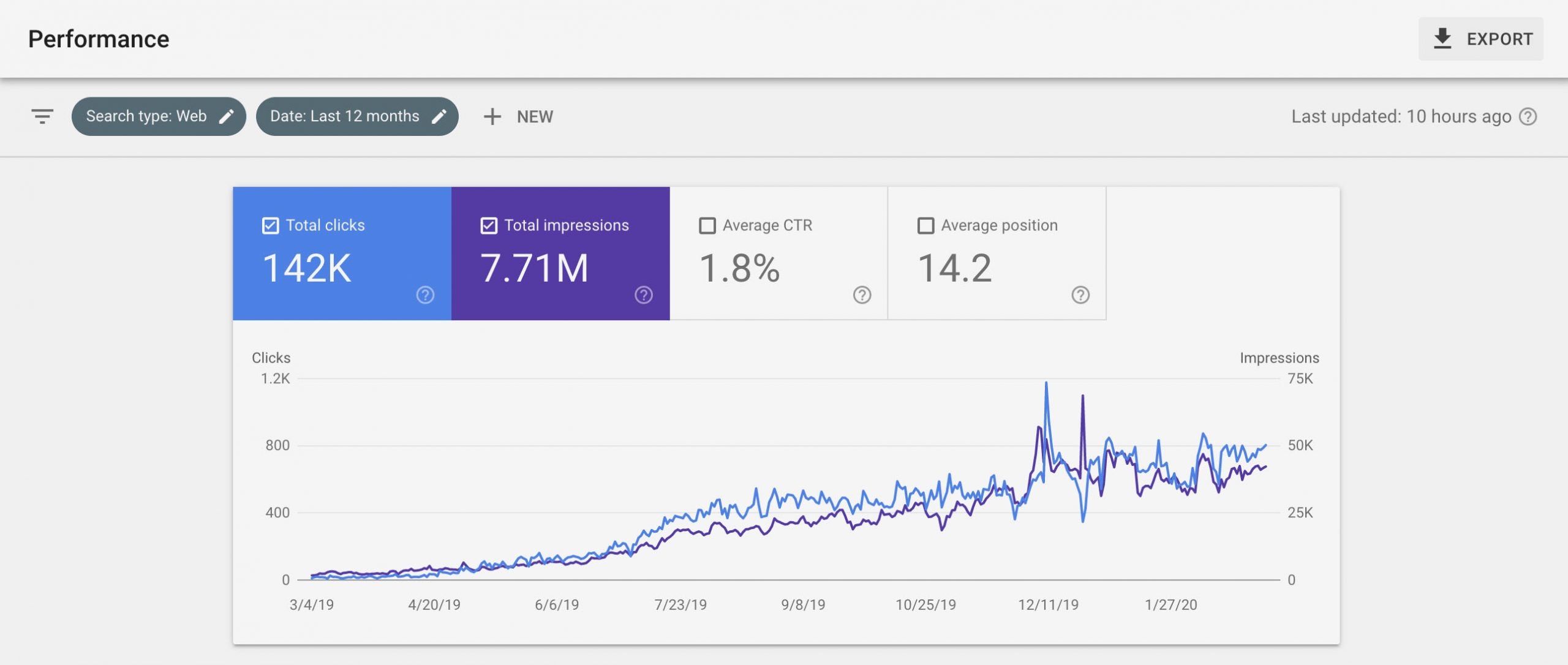
You should have Google Analytics installed and Google Search Console (GSC) set up prior to launching a website.
These free tools will help you not only see what keywords, long tail queries, internal links, external links, page views, bounce rate, or other sources send users to your website, but also how they behave on the site, site performance, and more.
GSC will also help you understand how search engines view your website and allow you to submit the site and any refreshed or updated content to be crawled or recrawled and indexed.
GSC is also a free tool that helps you with keyword ideas.
Haven’t installed Google Analytics yet?
Start with these quick instructions on setting up Google Analytics right now.
To learn more about GSC, visit Google’s official Google Search Console page.
If you are looking to add more tracking to your website, you should also consider using Google Tag Manager.
Google Tag Manager can hold all of your tracking codes in one place, and has a full array of tools in place to make sure everything is working correctly.
Here is the start to a series of great tutorials on how to get started with Google Tag Manager:
Keep reading to learn about the various metrics and ways to track and monitor your site’s rankings.
Search Engine Crawling
The search engine bots are constantly crawling or traveling throughout the web in order to categorize and rank the latest content, keeping the search engine web page results up to date and accurate.
After you launch a new site, blog post, landing page, article, navigation links, schema markup (structured data), or anything else online, you’ll want to ensure that it is crawled and therefore indexed.

You should have Google Search Console set up for your site before you launch it, and once you make it live and whenever you make any updates, you should use the Search Console URL inspection tool and have your site recrawled.
Search Engine Indexing
Being indexed by search bots are what happens after your website is crawled.
It’s the next part of the process after the search engine spiders have parsed your site and determined what keywords are relevant and how to rank the site accordingly.
The actual search engine index is where all the data is stored and it is regularly supplemented by search engine bots crawling the web for fresh content.

Search Engine Ranking
Theoretically, Google, Bing, and other referral sources rank the most relevant and most useful landing pages at the top of the results for a given keyword.
Your site’s ranking would be its position in the search engine results pages for each query that you’re targeting; generally, search engine rankings are referred to as “page one” or ranking on the first page of Google, Bing, or other data engines.
Page one results or search engine rankings are considered to be anything in the first landing page of organic results (located under the paid search ads), while position one is the top organic position below the paid search ads as well as the local map pack, featured snippet, or product page carousel (if applicable – more on those types of listings further on in this article).
Sometimes the aforementioned types of results are referred to as “position zero” in the search engine results since they are located above the paid search results.

Understanding Search Intent
Search intent or user intent is defined as the goal that the user has when they enter a search term, multiple search terms, or the “why,” or the reason they typed those particular words into the search box.
For (a perhaps overly obvious) example, if someone is typing in “what is SEO” or “how to do SEO” into the search box, then their intent is to discover the best info about SEO basics for beginners that they can possibly find.
One of our most valuable search engine marketing tips I can mention is really examine your audience’s intentions when they type in a query for a target keyword.
Sometimes a searcher’s intent is fairly obvious – for instance, if they are searching for a specific product or website, their intent is fairly clear.
However, if they are searching for something a little broader, it is less clear.
To use an obvious example, a user could type in “Amazon” and either be looking for information about the Amazon River or perhaps more likely at this point in time, to shop at Amazon.com.
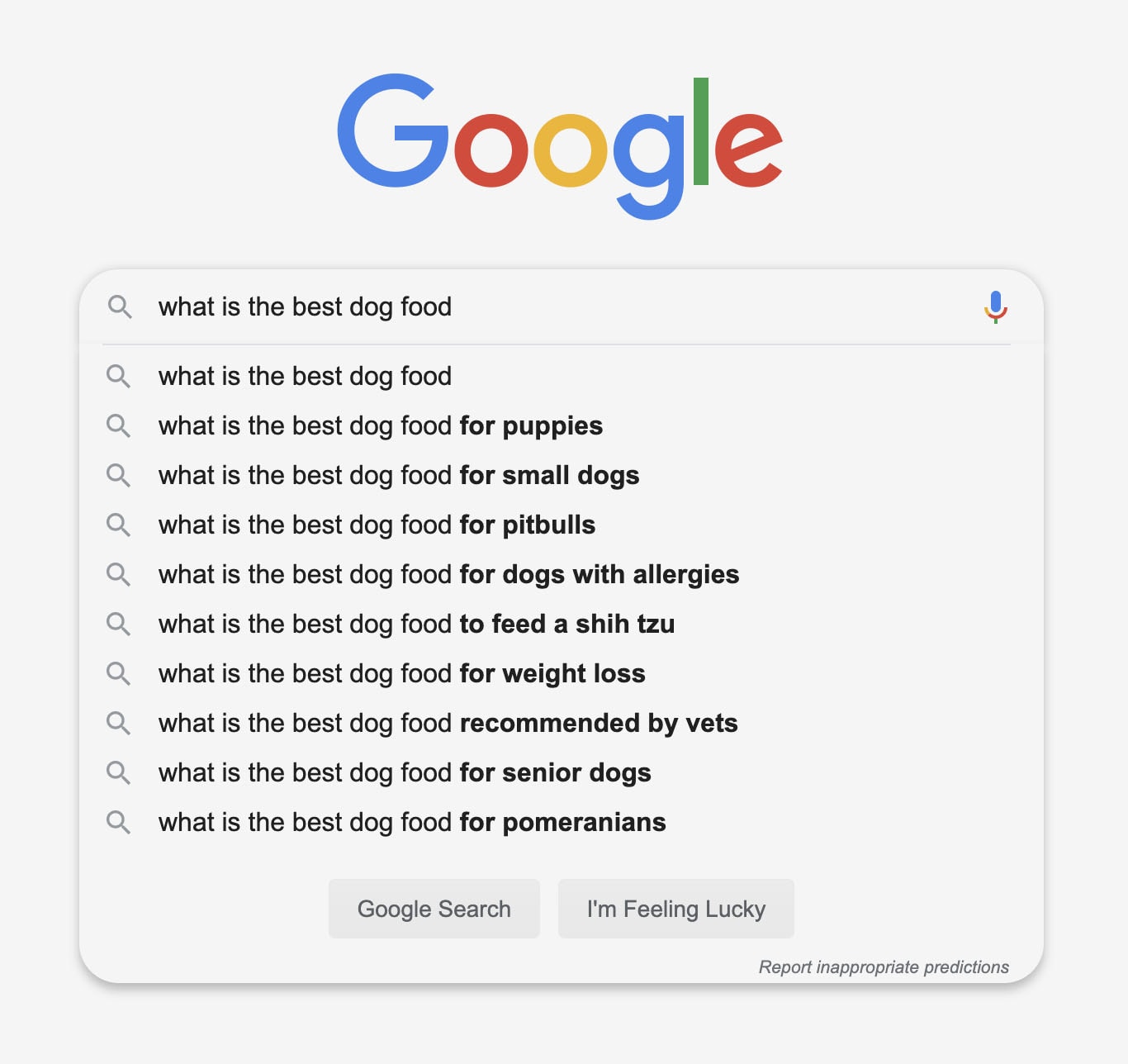
One of the quickest and easiest ways to determine what search intent may be is to utilize Google’s very own search box.
On a final (and important) note on search intent, when we perform company audits after a loss in ranking from a Google algorithm change, content quality can be one of the main variables on a list of other issues.
The context of content may be too broad, or it might not provide a comprehensive answer and fulfill user intent.
Here’s a practical guide on search intent that can help.
Keyword Research

There are dozens if not hundreds of ways to do keyword research; in fact, choosing the keywords that might work best for your site and your business is perhaps one of the most complicated and difficult aspects of advanced SEO.
You can start your keyword research process by taking a look at Google’s Keyword Planner Tool – even though they are meant for Google ads (formerly Google AdWords) and paid search, not SEO, you can assess a general idea on volume of a given keyword and see related terms fairly easily using Google Keyword Planner.
Seed keywords is another great tool that lets you see what people actually type into web searches – their search intent – which is incredibly valuable information for anyone who’s promoting or marketing, well, anything.
UberSuggest is another useful tool to check out, since it scrapes Google autocomplete data to show you what Google might suggest to users who are starting to type your targeted keywords.
We also always suggest going to your competition’s websites and checking out which keywords they are targeting – you can use paid tools like Moz, BrightEdge, SEMRush, Screaming Frog, or Ahrefs to analyze your competition’s link profile, or even do it the quick and dirty way by looking at the source and see the meta tag descriptions and full title tags for each other page.
Once you’ve implemented your content strategy, use Accuranker to follow your keyword rankings progress.
Use a site operator to quickly find web pages that are indexed in Google.
The site operator is easy, just plug in site:example.com and you’ll get a list of landing pages that are indexed in Google’s search results from any website.

There are also plenty of free and paid tools that you can use to check out the difficulty of ranking for a given keyword and finding related terms.
The aforementioned paid tools will definitely help, but there are some free options like SEO Powersuite or Small SEO tools.
Improve Your Domain Authority

Domain authority can be described as the value that Google and other search engines assign to your website.
For instance, articles on sites like Fox News or the New York Times are considered to be more authoritative on a given topic than a brand-new blog.
Link equity aka “link juice” is what helps a search bot determine the relevancy of a website or web page.
Moreover, high domain authority sites almost always earn a higher position in the search engine results pages, so working to boost your own site’s authority by creating useful and popular content and building high quality backlinks will help to improve your own position in the search engine rankings.

Understanding EAT – Expertise, Authority, and Trustworthiness
If you’ve done any kind of research about SEO and web search in general, you have most likely come across the “EAT” acronym.
It means “expertise, authority, and trustworthiness” and essentially covers all the elements that make up a quality website according to the algorithms that power the search engines.
It’s an SEO method or philosophy that is meant to sum up the way that search engines view, understand, and determine how to rank websites and you’ll often see advanced SEO experts and digital marketing professionals use EAT to describe how to view the overall process of search engine optimization.
For a better understanding of EAT, check out Marie Haynes EAT write-up.
Core Web Vitals
With Google’s core web vital announcement, core web vitals is now a ranking factor.
For years, marketers have known that an enjoyable experience on the web is crucial for a website’s success.
Not only that, but Google continues to roll out products built for helping you with the ultimate page experience.
Now that you know what core web vitals are, head over to Google Search Console.

Because Google only uses mobile first indexing now (the desktop version of your site isn’t used by Google anymore), you’ll want to focus on your mobile core vital report.
This is an answer for legacy and very large websites that utilize 2 separate entities for mobile & desktop URL’s that want to improve their core web vitals experience.
Anything in red needs an overhaul or improvement.
Animated images, videos, and screenshot pngs are usually the culprit.
WordPress themes, economy hosting, and ecommerce with lots of products can also hurt your core web vital report.
It is important to talk to your web design company about page speed, and what can be done to improve your website’s performance.
Interesting in how to improve your website?
Learn how to improve your core web vital report with this simple but complete guide.
How to Optimize for Visual Search

Google images and other visual search tools are growing in popularity, so naturally you’ll want to make sure that any images on your website are set up to capture those queries.
The file names for your images should contain the keywords that you are trying to target that are relevant to the image in question, and so should the ALT tags.
What are ALT tags?

Also referred to as the “ALT attribute”, “Alternative Text”, or “ALT description”, “ALT text”, the ALT tags are a description of the image that is part of the HTML of your website.
They are used as a way to make the image accessible to visually impaired users and also as a way for the search engines to categorize and index image search results.
Yoast’s post on advanced SEO and ALT tags is an excellent read to learn more tips on strategy and optimization.

How to Optimize for Audio Search
SEO is an evolving, multifaceted strategy to increase visibility online.
With that said, and at the original time of writing this, audio search is still a work-in-progress.
To get the latest usage stats on audio search, check out this updated voice search stats roundup.
Voice search or audio search have become an increasingly common way for users to find what they are looking for – with Alexa, Siri, Cortana, Google Home, and others helping more and more people out every day via various devices, understanding how voice search or audio search works is critical.
Voice search or audio search are the results that you get from speaking directly into your device of choice versus typing a query into Google or Bing.
For instance, if someone says “hey Siri or hey Alexa, find me a plumber in my area ASAP!”, and you’re the local plumber, you’ll want Siri or Alexa to tell that person about your company.
The first thing to understand about voice search is that voice queries tend to be longer and more specific than text queries, and they often start with question words such as “who, what, when, where, why, or how”.
You can use these queries to structure article titles and headings, e.g. if you’re a dentist or responsible for marketing a dental practice, “How to choose a dentist?” or “what should I do if my jaw hurts?” or similar questions.
If your website isn’t tied to a digital location (for instance, if you’re a consultant of some kind, a graphic designer or artist, or similar), you could go with queries like “how to find a graphic designer?” or “where to get a customized oil painting?” or whatever type of service or product applies to your business.
And of course, “dentists in (your location)” should also appear along with a Google maps listing if you have a physical location or brick and mortar store so Alexa, Siri, Cortana, and Google Home can all help bring customers to you with their answers.
It is perhaps even more important to understand that loading site speed is crucial for voice search, since these digital assistants have to answer their queries quickly – so the quickest page loading times will be rewarded (check out our article on how to make a website in 2023 to learn more).
By now, your site should have an SSL (your URL will begin with “HTTPS”) to help Siri, Alexa, Cortana, and Google Home trust your website – using https is essential for websites in general, since search operators prefer secure sites that are quick to load and therefore provide an optimal user experience.
You can also add voice or audio files to your website – such as audio versions of your text-based content like blog posts and articles – if you really want to invest in voice search.
Finally, focus on providing a featured snippet or opening text that is not only keyword rich, but sounds engaging and compelling being read out loud by a digital assistant.
Keep reading to learn more about how to get your website listed as a featured snippet in Google for your chosen keywords.
Understanding audio search will only become increasingly important in the future – Comscore estimates that in 2021, approximately 64% of all searches will be voice search.
So, start things off right and beat the competition by optimizing your website for voice search right away.
You’ll find some great tips on WordStream’s Google Voice Search post.

How to Optimize for Video Search
Did you know that YouTube search traffic is the second largest search engine after Google itself?
A video site that is the second largest crawler is a great opportunity for organic search traffic.
Being able to have your videos show up highly in a prominent search result on YouTube as well as Google will go a long way towards getting you views, subscribers, site visits, and eventually leads and customers.
One key way to optimize your video content for organic traffic is to include a transcription or a subrip/subtitle (SRT) file.
Since the search engine bots can’t watch video content themselves, this lets them know what that piece of content is all about.
These types of files also allow for captions on your videos, making them more user-friendly – keep in mind that your audience might be watching your videos without the sound on, which is increasingly common, especially on mobile devices.
Of course, you should also include an engaging thumbnail, a keyword rich title and description, and ensure that any page that you embed the video on is also optimized and provides a description and even a transcript of the video – after all, you’ve already created one for the SRT file.
You should embed the video at the top of the landing page above the text, and make the video the central feature of the page as well.
Instead of having to produce an SRT file, Rev can do the captions for you, or they can take your videos and create a transcription giving you not only an informative YouTube video, but a new written post as well.
Why Should You Study the First Page Search Engine Results?

Understanding what type or types of content rank well for your particular industry or niche and your ideal keywords is an essential skill.
Are there particular types of content or websites that are at the top of the SERPs?
If you are researching long tail keywords, are the landing pages long articles or shorter posts?
Do your competitors offer video or podcasts?
What’s more, study what shows up on the featured snippets, local SEO pack, or product carousels, if applicable?
Check out Search Engine Journal’s complete article to Google snippets and where they stand today.
You should ensure that your site and its content are optimized to take advantage of these features.
Other things to look for is if there are heavy ad placements for a set of search queries, then there is a good chance that you’ve found an actionable keyword that fills search intent.
The main goal of studying the first page of the SERPs is to see what SEO techniques your competition might be using, and then to mimic the successful SEO methods yourself in order to improve your own rankings.
What is a Featured Snippet?
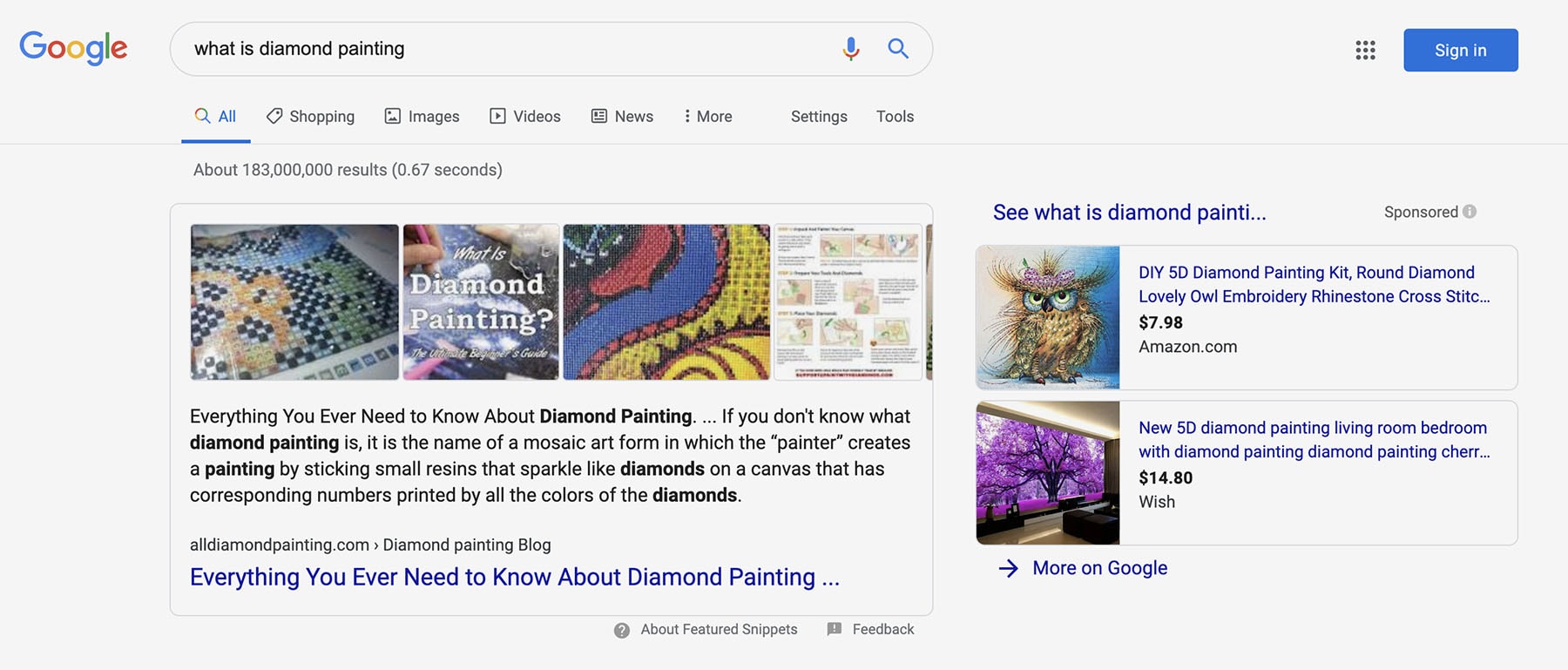
A featured snippet or an “answer box” is the chosen organic result that appears at the top of the listings (above the paid search ads) and has a box around it to highlight its importance.
The goal of a featured snippet to immediately answer the query or question that the user is asking.
Getting your site or business into featured snippets can be incredibly valuable, since they take up so much real estate at the top of the first page of the results.
In addition, featured snippets (or the equivalent opening text or description), is often what voice search reads to the user – so as you write the text, imagine it being read by Alexa, Siri, Cortana, or Google Home.
As of late, there has been a lot of hype around FAQ snippets, as discovered by Mathew Woodward.
Google has also rolled out “passage ranking,” and it will take a passage of a page to fulfill a search query.
Featured snippets are a bit different – Google takes an entire page’s relevancy to the question, where a passage ranking only looks at each passage on a page.
Authoritative sites will win, but low quality or thin content sites will also win if they have a more relevant answer.
Here’s a further write-up on Google passage ranking (hint: you probably don’t need to make any drastic changes to your SEO goals).
What Is an Information Box?

Information boxes are the results that you sometimes see in the right sidebar of the SERPs.
You’ll see them for celebrities, major events, historical figures, most geographic locations, and perhaps most importantly for anyone reading this, businesses or brands.
You can get your own information box that will pop up when people search for your name or similar keywords by setting up your Google My Business listing – which you should do anyways in order to get set up in Google maps, get reviews, and more.
Make sure that you add a keyword rich short description, plenty of relevant images (make sure the file names contain the keywords and area you’re targeting as well), and of course your website and any other relevant internal links like contact forms, online ordering, appointment forms, and more.
BrightLocal’s Google My Business optimization guide is a great place to getting started on your GMB profile.
Localized Search Engine Optimization

If you have a business with physical stores or locations or one that works in a specific geographic range (e.g. a lawyer, roofing contractor or real estate company), you’ll want to fully understand the unique specifics of local SEO and search traffic.
You’ll want to include your location or locations in your content as often and as naturally as possible, optimize your meta description and page SEO titles for your location, and of course build out the previously mentioned Google business listing and ensure that your location on Google Maps is accurate.
Additionally, you should also make sure that you claim your listing on Yelp, TripAdvisor, Angie’s List, and any other site that is popular in your industry, as well as building out as many possible social media profiles to include your name, location, and address – even if you don’t intend to post much, better to claim your business name and get your link plus location in there, and to defend your brand against an online reputation attack.
Localized SEO techniques are all about making it as simple as possible for your potential clientele to discover your business and visit you or otherwise engage with your brand.
What is a Local Map Pack?

Locals map packs, found on Google, combine localized search listing with Google maps, so you can see the nearby options quickly.
For example, if you are searching for “vegetarian restaurants” Google will likely show you the results for restaurants that have vegetarian options.
On the other hand, if you are searching for something broader like a historical event or a celebrity’s name, you will be unlikely to get a local map pack – but that’s really irrelevant for most localized businesses.
If you run a solely digital or online business and do not have a brick and mortar store, the local map pack optimization most likely shouldn’t be your biggest concern either.

How to Rank in Local Search
Local search or localized search traffic can be a great way to introduce your business to people in your immediate area who are already interested in what your business has to offer.
BrightLocal and WhiteSpark are good tools for localized SEO.
Brightlocal is recommended for its highly detailed local SEO audit tools, while WhiteSpark has great citation and listing management capabilities – ideal for businesses with multiple locations.
Ranking in local search starts with setting up a Google My Business listing – which of course should include an enticing, keyword rich description, and images of your products, your shop, or other relevant pictures.
You’ll also want to make sure that your address on Google is 100% accurate, since that is where the local map pack draws its information from, as well as a 100% match to information you provide on external business citations, like Apple Maps and Bing for Business.
Also, check out Google’s source code on the top 3 ranking map pack competitors and find out how Google is categorizing them.
If the categories fit your business, be sure to include that category in your GMB profile.
Ensuring that your website is mobile friendly also helps to improve your local listings, since people searching for nearby businesses or services tend to be using mobile devices now more than ever.
Don’t forget one of the most important parts of your business, your reviews and testimonials!
Although there hasn’t been any definitive evidence that reviews will raise your organic search results, reviews do play a big factor in a consumer decision on whether to buy or not.
What is a Product Carousel?

A product carousel is the array of options that show at the top of the Google listings (before the paid search ads) that you can scroll through when you search for specific products.
For instance, if you search for “Nike sneakers” or a similar query, you’ll get a carousel of options from various ecommerce outlets above the paid search ads and organic search engine results.
Product Examples in the Product Carousel
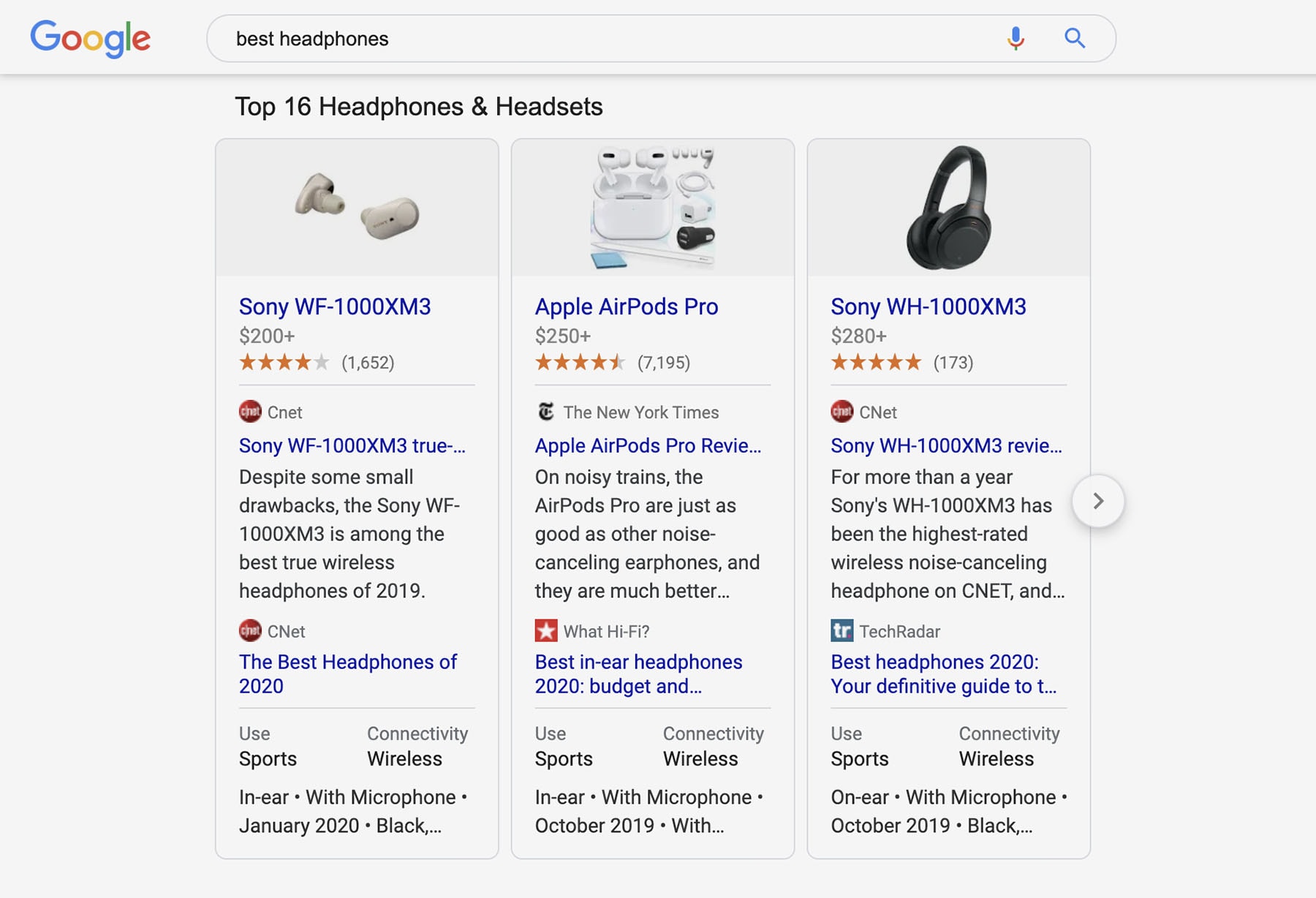
If you have an ecommerce site or sell anything online, then you’ll want to make sure that your individual products are properly indexed so they can appear in the product carousel.
This includes creating keyword rich title tags and description that include brand names, colors, sizes, prices, and any other applicable factors.
You should also have a consistent naming convention in your titles and URLs, such as www.site.com/shop/product/brand/style or similar.
Note that ecommerce platforms like WooCommerce or Shopify make this relatively simple to accomplish.
Of course, having compelling images of items is also key, along with ensuring that your site is optimized for search traffic.
And like all types of SEO, page speed and page load time is critical – sites that load quickly tend to grab more conversions.
Although there isn’t a definitive guide we can share, here’s the organic carousel background story on when Google launched it.
What is CTR or Click-Through-Rate?
As it relates to SEO, your site’s click through rate or CTR is the rate at which people see it in the search results and decide to actually click through and visit.
CTR is also considered to be a potential ranking factor for organic search, depending on who you consult.
This is based on the idea that sites with a higher click-through-rate have a better chance at giving search engines signals that people generally like your content when “ dwell time” is considered.
To write for a good CTR, the same principles should apply when writing for paid ads.
Think of driving down the highway and seeing billboards, generally the billboard that grabs your attention is the one that creates an actionable inquiry.
The same applies to the first page of search results, the best written page title tag and meta tags description generally can win over the highest ranked websites.
Here is a great write-up on how CTR affects SEO.
What are the Best SEO Tools?
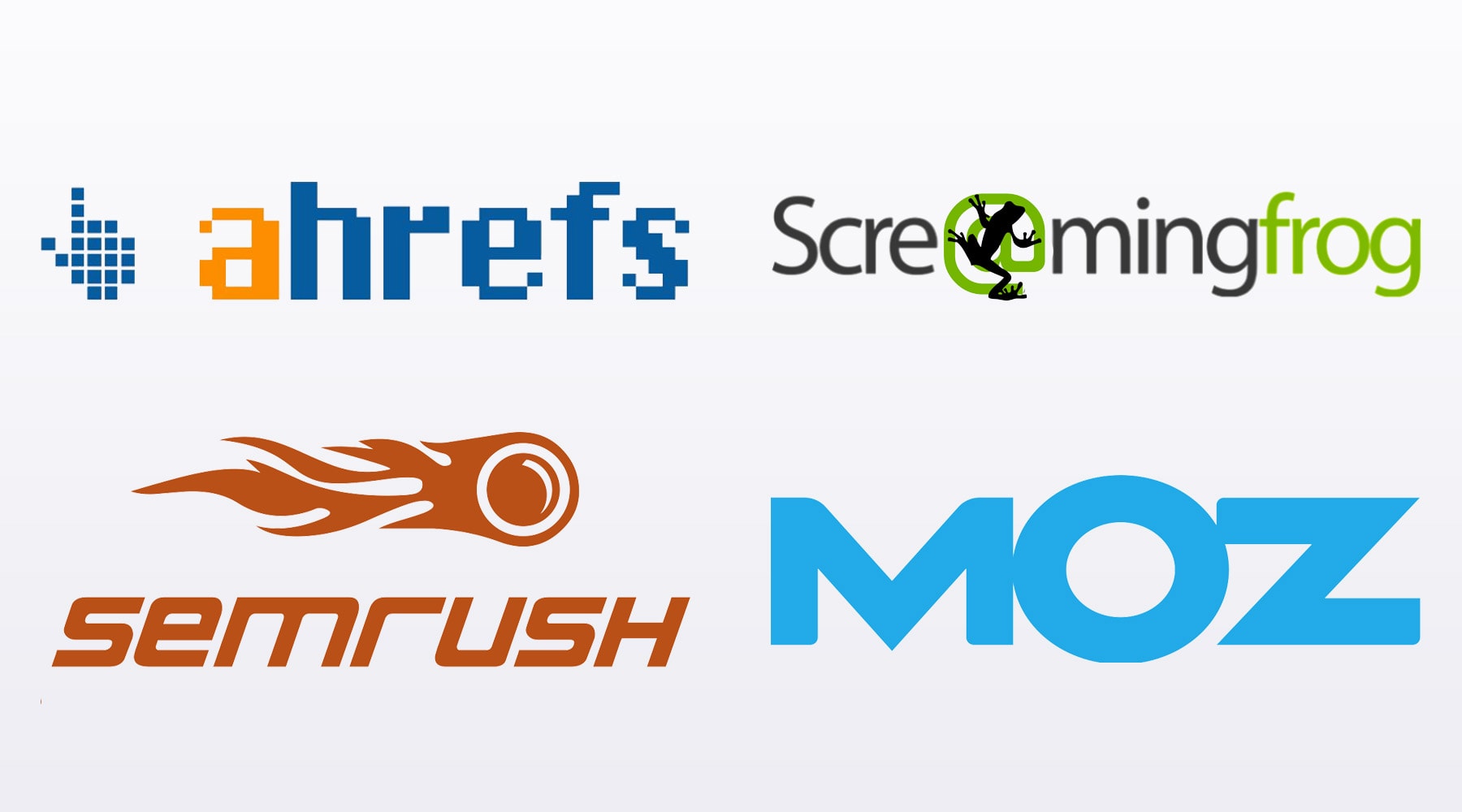
If you are starting to delve into learning more about SEO and optimizing your website, chances are that you’ve encountered a wide range of options for SEO tools – and an equally wide range of price points for said tools and SEO software.
Some of the most popular and well-known are Ahrefs, Moz, Screaming Frog, BrightEdge, Majestic SEO, SEMRush, WooRank, WebCEO, and Raventools; that said, there is a range of SEO tools at all price points.
Ahrefs
We tend to recommend Ahrefs as a great SEO tool for most website owners – the subscription plans range from $99 to $999 per month, and it allows for competitive research, keyword analysis, keyword difficulty, SEO metrics, site audit, and more.
Plus, it is fairly user friendly for SEO newbies but advanced enough for more experienced users.
Their support is responsive, they have an active Facebook group, and they are constantly making updates to make their tools better.
Even more important, they listen to feedback from their customers.
Ahrefs offers a 7-day trial for $7, so it is definitely worth trying out.
If you do decide to make this one of your tools of choice, the Ahrefs blogging for business for free and will help you fully maximize your Ahrefs experience.
Moz
Moz is also one of the gold standards of the search engine realm, and offers a variety of free tools as well as MozLocal for localized SEO and MozPro for more advanced users.
It is slightly more expensive than Ahrefs – prices start at $179 per month – but Moz also offers a wealth of resources including SEO training.
If you are using WordPress as your CMS, Yoast SEO, The SEO Framework, and All-In-One SEO Pack are helpful plugins that allow you to optimize your site for search even if you are not particularly technically inclined.
Almost all of the SEO tools offer free trials so you can test them out before you commit, so don’t hesitate to check out a few and see what tools or combination of tools that you prefer.
On-Site Versus Off-Site Search Engine Optimization
When you are researching search engine optimization techniques, you’ll often come across guides to on-site SEO and off-site SEO.
Think of on-site SEO as building out the technical aspects of everything and getting your house in order for Google, Bing, and the other search engines to visit.
Some on-site SEO techniques include internal linking throughout your entire site, by internally linking pages you are giving search operators multiple paths as well as a basic understanding of how things relate.
Anchor text can be both on-site and off-site SEO techniques, here’s a good anchor text write-up from Moz.
Off-site SEO is sending the invitations out in the form of backlinks, social media posts, and more to help the search engines, and therefore your target audience, discover your site and what your business or brand has to offer them.
To dive deeper into on-site SEO vs Off-site SEO, this guide will help you out.
Understanding Technical SEO

Technical SEO is the science of building your website in such a way that it is thoroughly crawled and properly indexed and considered to be a relevant source of authority for the keywords that you are trying to rank for.
Think of technical SEO as building the foundation of your site.
There are many different elements of the site-building process that can be considered aspects of technical SEO, including but not limited to:
- Creating keyword rich titles and meta descriptions
- Building your menus with breadcrumbs so that the search engine bots can accurately and easily crawl your content
- Adding the appropriate H1, H2, etc. meta tags to each page SEO
- Creating a robots.txt file
- Creating an XML sitemap
- Setting up canonical URLs
- Getting a secure sockets layer (SSL) certificate and setting up HTTPS for your domain
- Having a mobile friendly site (and possibly using accelerated mobile site pages (AMPs).
- Setting up pagination with rel=”next” and rel=”prev” if applicable
- Setting up your Google Search Console, Google Webmaster Tools, and Google Analytics.
Get the foundation of your website right – SEO aspects – is crucial for achieving good positions in the SERPs and a successful search engine process.
For more advanced SEO’s, Screaming Frog is generally the tool of choice, but is a tool that requires some learning.
Seer’s Screaming Frog guide is a great place to get started.
What are Backlinks and Why are They Important?

Backlinks or external links are links from other websites to yours.
Getting high quality backlinks is important because backlinks from high domain authority websites lends your website more credibility and helps you get higher search rankings.
Not to mention, if your site is linked to from a popular website, you will likely see an organic traffic increase from users who are already interested in your content.
Without a doubt, cultivating backlinks requires patience, an SEO strategy, and commitment.
And, without a doubt, Brian Dean from Backlinko has built one of the best SEO hubs on the planet, including innovative ways to get more backlinks.
Check out his backlink strategies from his SEO marketing hub.
And better yet, sign up for his incredibly useful newsletter.
How to Get Backlinks
There are a variety of ways to get backlinks.
You can purchase them via linkbrokers or from directories (although the search engines may penalize that activity).
You can find broken links on popular websites, and offer up content to replace with your own.
You can earn them by creating high quality content that others want to link to and share.
Typically, SEO companies or SEO professionals use a mix of the aforementioned tactics.
SEO tools like Ahrefs, Moz, and Buzzstream (more on those further down in the post) can help you scan your backlinks to look for new opportunities as well as analyze where your competition is linked.
After all, if a given site links to your competitors in your industry, they might link to you too – especially if you can provide better content resources.
If you want to get featured in various publications, using Help A Reporter Out (HARO) or Pitchbox to find journalists and publishers who cover your industry or category can be invaluable.
As you can see, there are nearly as many ways to build backlinks as there niches on the web, but here are some of the primary backlinks building strategies that tend to be the most effective.
-
Be Inspired by Your SEO Competition
Looking at the sites that link to your competitors is probably one of the easiest ways to build backlinks – you can use a tool like Ahrefs to see where your competitors are linked and how high the authority is of each site.
If it’s relevant, you can contact the owners of those sites and let them know about your business and any resources or offerings that their audience might find useful.
You can also write a better, more up-to-date post that can replace content that requires a rewrite.
-
Become a Valuable Resource with Infographics and Tutorials
Infographics and tutorials are excellent linkable content and by creating helpful or entertaining (or both) how-tos and guides that are related to your industry and what you have to offer, you can become an important resource for other web publishers.
For instance, if you are a general contractor you can show people how to do basic home repairs, or if you are a salon owner or stylist you can create simple hairstyling tutorials or show off the latest hair trends.
-
Look for Broken Links to Repair
Broken links can be a good source of backlinks as well – you can check sites that you think would be interested in linking to your content (using the aforementioned method of scanning the backlinks that others in your industry or niche have already earned) and use tools like a Google Chrome extension called “Check My Links” to check them for an error page or link issues that you could potentially replace with links to your site.
If you’re using Ahrefs for broken link building opportunities, here’s a quick video on broken link building strategies and tips on outreach emails and how to find email addresses of content creators.
Then you can reach out to the owner or editors of those sites and introduce yourself and offer your site as a potential replacement.
Be sure to include specific URLs and explain why your content is an ideal match.
-
Use External Web Profiles Wisely
Social media backlinks may not be considered as valuable as other types of backlinks, but if you think outside of the typical Facebook/Instagram/Twitter box Quora is a good place to look for content ideas as well as a good place to create backlinks – you can link to articles that you’ve written if they answer the question being asked on a given topic.
Ahref’s wrote up a great SEO strategy on how they achieved 1,000,000 views from posting on Quora.
Same goes for Reddit and its various subreddits that cover almost any niche – but be careful to follow guidelines regarding self-promotion on these or any other social platform in order to avoid backlash or even being booted or banned from the sites.
-
Write Guest Posts
Crafting a guest post for a high authority blog or website can be a great way to build backlinks while also introducing your brand to a new audience.
You could also consider appearing as a guest on a video channel or podcast with the goal of spreading your expertise.
Being a guest of any kind can be a great way of creating awareness and building trust with your target audience – after all, if you are worthy of contributing to a high-quality publication, then you definitely know what you’re talking about!
-
Haro
Help a reporter out.
Reporters are seeking answers and information on a wide range of topics via email requests.
By helping them out, you have an opportunity to earn a link – the ultimate PR SEO strategy and overall marketing strategy!
-
Flatter Others in Adjacent Fields
Another option is to link out to sites or resources that are not direct competitors but in aligned or adjacent industries or categories.
If you add flattering or complimentary links in your articles or posts, there’s a very high likelihood that the editors or publishers of these sites will share that link with their audience.
Everyone loves a compliment!
-
Paid Backlinks
Backlinks can be difficult to build in an organic or natural fashion, but the reward of great organic rankings can be great.
Also, keep in mind that search engines may penalize your site if you build too many backlinks too fast, buy backlinks to pass page rank, or otherwise develop an unnatural backlink profile.
There are so many ways to build backlinks and you can use many of the same research methods to find content to use as a resource and draw inspiration from when you are writing blog posts or a press release, articles, scripts for videos, outlines for podcasts, social posts, paid ads, or any other kind of content that relates to your website and your business.
One key thing to always remember when you are building backlinks via any kind of outreach to other publishers, site owners, editors, or webmasters is that you are essentially acting as an ambassador for your business or brand – you can and should think of it as doing public relations work on behalf of your website.
So be friendly, be useful, and think of how linking to your site could benefit them, not the other way around.
What is Domain Authority and Why Does It Matter?

The domain authority of a website is defined by the prestige of its authors or origin, the quality of the information provided, and the competition around the central keywords and the industry that the website is targeting.
Search engines use domain authority to determine where to rank your website and for which keywords.
The term domain authority was first coined by the team at Moz (one of the more elite paid SEO software options), but it is now regularly used by many SEO and digital marketing professionals to define the strength and value of a given website.
Domain authority is assigned on a 100 point scale, e.g. a 100/100 domain authority is the highest a site could possibly earn, and that’s nearly impossible.
Having a high domain authority for your keywords or topic(s) is the ultimate goal, but it is also important to understand the value of getting backlinks from high domain authority sites.
Google and the other search engines place more value on a high domain authority backlink, particularly if the site linking to you is in a similar industry or an established publication (e.g. the Washington Post or the New York Times).
This is referred to as citation flow or trust flow (or CF and TF on some SEO forums and blogs) and Google uses these as ranking factors.
Why Your Homepage Has the Most Domain Authority
Your homepage is probably the most important page on your website, and for good reason.
It’s the main portal that allows your customers and prospective customers to discover who you are and what you have to offer, and the search engines almost always grant the highest level of domain authority to the homepage.
To further add, because most external link profiles point to your homepage, it is a good idea to get the content you want to rank for most to appear on your homepage.
How to Check for Cannibalized Content

The definition of cannibalized content or copied content can vary depending on your situation.
That said, cannibalized content or content cannibalization occurs when two or more pages on your site target very similar or the same keywords or group of keywords, and therefore are competing against each for search rankings.
How do you solve the problem of cannibalized content?
If you have two web pages or posts that are overly similar, you can likely combine them into one super long article.
And there’s an added bonus to this tactic – search engines tend to reward in-depth articles, pillar page, or posts with higher rankings, since they are considered to be ultimate resources that provide relevant information.
Although, many SEOs are skeptical about cannibalization, we’ve experienced first-hand where one targeted query can confuse the Googlebot, knocking results down for both pages on your site.
Setting a proper canonical tag usually fixes this problem – Ahrefs has a great write-up on keyword cannibalization and canonical tags along with a tool that you can use right now.
Creating Cornerstone Content

While the idea of writing massive blog posts or articles that are comprised of several thousand words or more may seem daunting, creating “ultimate guides” or longer pieces can be better for SEO than writing multiple shorter pieces (and note that you don’t need to bang out 5000 words at once – a couple hundred words per day will become a long article or guide before you know it (and you can always extend or update an article after it’s published).
When you’re looking at topics for cornerstone articles or blog posts, start with keyword tool research and competitive analysis.
Writing an anchor or cornerstone post centered around each of your main targeted keyword categories is a great way to start, and you should also check out what kind of significant articles or posts your competitors have created.
How to Improve Your CTR

Your site’s click-through-rate or CTR might be one of the most valuable metrics that you track.
The click-through-rate is the number of users who see your listing and actually click on it and visit your site versus the number of impressions that you’ve received.
While calculating CTR when you’re doing paid search or other paid ads (display, social, etc.) is fairly simple, it becomes a little more complex when you are looking at the CTR from organic search results.
Organic click through rates are based on your site’s ranking, natural relevance to the user’s query, but the URL or domain name, the text in your rich snippets, and placement and thumbnails in the product carousel or local map pack also definitely matter.

Why You Should Rework Content That Isn’t Performing Well
Sometimes even if you think you nailed it with a blog post or article, it’s just not hitting the mark with the search engines or your audience.
Over time, your post becomes less relevant than other posts, sometimes you might have new SEO ideas for structuring the content or new keywords to add, or sometimes it is just because the content itself is outdated or “old news”.
But all the work that you originally did is definitely not wasted, it might just require some updated tweaks, some updated SEO methods or more effective techniques, changing some keywords, improving schema markup, simply making the article longer (in our experience, word count has some relevance in search rankings) at page level or adding more high domain authority links (or both) to help boost your article, post, or page’s authority in the search engines.
Quick Hits: How to Improve Your Site’s SEO

If you’ve got a website and you want to get more search engine traffic, and you haven’t done a lot of search engine optimization work yet, then there are a few things you can do to quickly make some positive changes using effective SEO methods and techniques.
Keyword tool research is absolutely key, as well as understanding search intent.
And that actually might be the most important aspect of SEO.
One note – void keyword stuffing, this outdated SEO tactic can result in a negative user experience.
Technical SEO is also essential, especially once you’ve figured out the keywords that you should target for the best results.
If you’ve recently added an SSL, and your organic traffic has dropped, use this excellent (and free) Google Chrome browser extension SEO tool made by the detailed.com team to easily find out if pages were correctly forwarded to the new SSL.
Some quick SEO techniques include making sure these keywords appear in your page titles, meta descriptions, and other content, as well making sure that your technical SEO is on point and you have built everything properly.
You’ve also probably determined this aspect of SEO if you’ve read this far, but adding a blog, news, or article section is a great way to quickly boost your site’s SEO, since you can constantly update your site with content creation and signal to the search engines that you have fresh information – and Google, Bing and other search engines reward sites that consistently have new or fresh content.
Effective SEO is all about making things better and easier for your users as well as making it as simple as possible for the search engines to discover and rank your content.
And layered on top of that should be a solid link-building or digital PR strategy that gets the word out about your site and encourages others to link to your optimized content.
In our experience, one expansive post that covers a subject in its entirety is better than multiple posts that only partially covers a topic.

SEO in 2023
One thing to remember when you are doing anything that’s related to marketing your website is that SEO is a constantly evolving field.
Not only are search engines always updating their algorithms, what is considered to be the “right” or best SEO practices are shifting as well.
How do you discover new SEO tricks or tactics?
Following the experts is one way – there are a lot of bloggers who write about SEO and other marketing best practices.
Frequenting forums or Reddit’s myriad subReddits that cover search engine optimization and related topics is also a good idea, especially since you can bounce SEO ideas off of others and discuss how to solve or troubleshoot your problems.
There are a lot of great Facebook groups about SEO, The SEOSignalsLab group is one that provide tons of value.
Modern SEO is always changing so knowing what the latest SEO technique is – as well as how it is useful or valuable for your needs – is essential in order to keep up with your competition for high search engine rankings.
The best SEO strategies and techniques are always the ones that model and adapt to whatever the search engines are currently using as their most important ranking factors, so keeping up with the trends and doing ongoing research is essential – or you can work with an SEO company that’s always up to date on the latest and greatest.
Hopefully this guide was useful, and it gives a good starting point.
Also, how did we do?
We love to hear feedback – what can we add?
How can we make this post more informative?
Leave a comment or suggestion below.
Increase Your Knowledge
If you’re looking to learn even more about SEO in a particular niche, check out these resources:
SEO for Lawyers: The Simplified Guide
A Simplified Guide to Roofing SEO
SEO for Dentists: The Complete Guide


This is one hell of a guide!
Thanks a lot for the mention of the Detailed extension.
Hey Glen! Thanks for stopping by, and thanks for the awesome tool – and your excellent content on SEO Blueprint.
Hi, our website lost 80 site visitors at the beginning of this month. Much of our sites disappeared from the first page in Google. We looked into a little bit as well as located that hundreds of sites took our content without consent. A lot of those simply copy and also pasted our web content. So we thought we require to build E-A-T so Google sees that our content is the initial. Since we have lots of excellent web links we believed it might be something on-page. I observed that most of the new top websites have schema.org increase witch mention the writers as well as the date of the released job. Considering that our brand name is stated around the internet, I ask yourself if it helps to include on-page author signals/tags to our site as well as if it should be an individual (pointed out quite no place yet) or a company (in our case the website’s LINK)?
Hi Young,
It is hard to tell what factors are in play without seeing a URL, but copied content is usually not a single factor for losing site traffic.
When using E-A-T, unless you are a very well known brand, you should try to use an expert in their field using author schema.
I hope this helps, good luck!
You have covered all the important topics. Thank you very much for sharing such an interesting article. Looking forward to reading such amazing articles in the future as well.
Thanks for the read, Shubham.
That’s really nice post. I appreciate your skills, Thanks for sharing.
Thanks for stopping by, let us know if there is anything we can add to help.
very useful seo tips thank you keep it up
Alliance Tech UK
Hi Ali,
Thanks for the compliment!